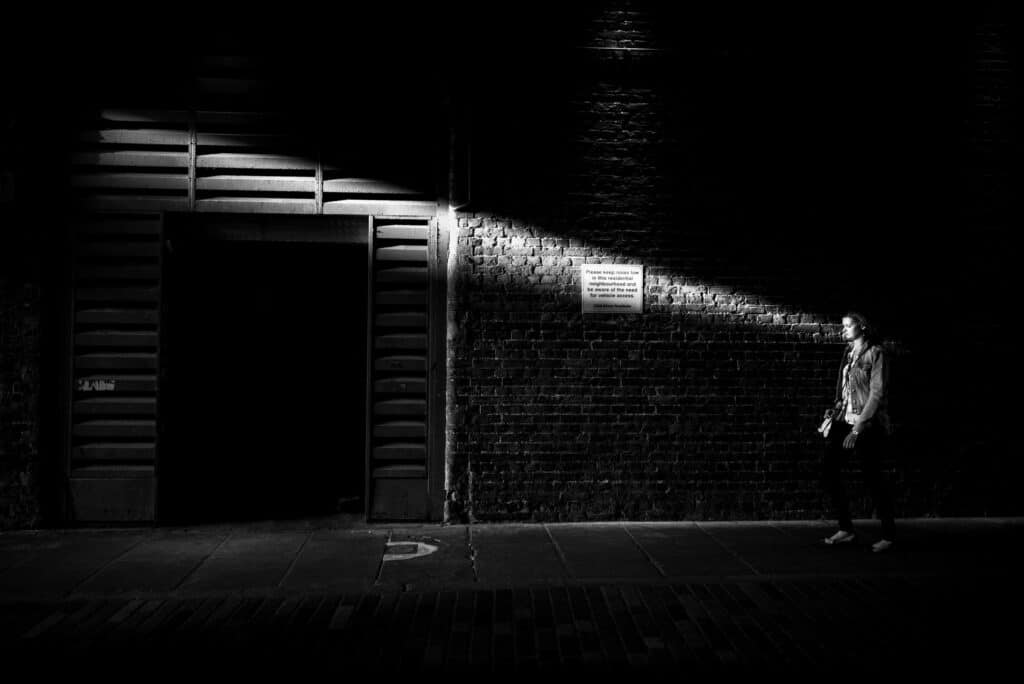On Wednesday 6 November, the Photography Society was delighted to welcome the widely known street photographer Alan Schaller, who was accompanied by his agent, Tim Paton. The audience was made up of budding photographers and artists as well as those who were simply interested in hearing from two big names working in the world of photography.
Alan kicked off his lively talk with an overview of his style which incorporates the use of geometric elements and negative space. He has become very well-known for concentrating solely on taking monochromatic photographs which he described as a conscious decision in an effort to stop his style from becoming diluted. This helped him hugely going forwards, as he became one of the few people clients would ask if they needed black and white photographs for a project. He described how it is important to become known for a specific style of photography, and do your best to hold on to it, particularly as there are so many photographers vying for critical attention.
Alan is a street photographer, so he proceeded in sharing some insights into how he became so successful at this genre. He shared the importance of remembering that ultimately street photography means you are using a camera to create interesting perspectives of every day environments: “it’s just you, your camera, and your eye, and you should always use different angles to work for you.” Alan stressed that one of the biggest misconceptions about street photography is that it is effortless and quick. He reiterated that his images are usually contrary to this – every shot is pre-visualised, and takes time to achieve.
Alan also mentioned how he thought of his work as part of a documentary of human life, and a measure of how it evolves constantly. Therefore, he stated that when taking photos around and about, “it’s not a good idea to draw attention to yourself.” Alan happily mentioned that he hadn’t “been shouted at in five years!”
Alan went on to give some examples the methods by which he took some of his favourite photographs, which included sitting on the floor of the British Museum for an extensive period of time, eventually prompting the staff to ask about his health. He joked that this was when he discovered that the museum used underfloor heating! Another example featured Alan waking up on a flight at just the right time (with coincidently, just the right lens on his camera) to capture an outstanding picture of Mount Fuji from behind the plane’s window.
We were next treated to a demonstration with his Leica camera which helped us understand how light is integral to a photograph, and how it should be made to work for the photographer. Alan also demonstrated how quickly and discretely he takes a photo in public, allowing him to capture his subjects naturally.
Alan then proceeded by explaining how he co-founded Street Photography International, a collective which represents talented unrepresented photographers – the millions who are not the famous few. Today, its Instagram account has nearly amassed two million followers, and the collective has become the most viewed street photography resource in the world. He also detailed how they started a photography competition which doesn’t cost a fortune to enter. First, 50,000 entered, followed by 100,000, and then 200-300,000. Alan described how the collective do all they can to boost recognition of the finalists of the competition, both digitally and through physical exhibitions.
Finally, we heard from Alan’s agent, Tim Paton. Tim described how he went from being a photographer himself, to representing 15 photographers, to being Commercial Director of Magnum Photos for eight years, to representing photographers again. Tim believes that anyone can take photographs and earn money from them, if the right people see your work at the right time. He used the example of a student at Bournemouth University who received an offer from Apple who wanted to own one of her photographs she had posted on Flickr. After Tim’s negotiations with the tech company, she finally received and accepted an offer of £45,000.
At the end of the evening, everyone in attendance felt fulfilled, having heard entertaining and informative talks from two figure-heads of their industry. It was another successful evening for the Photography Society, having been bought back from dormancy this academic year by its new secretaries Giacomo A and George C-C.










